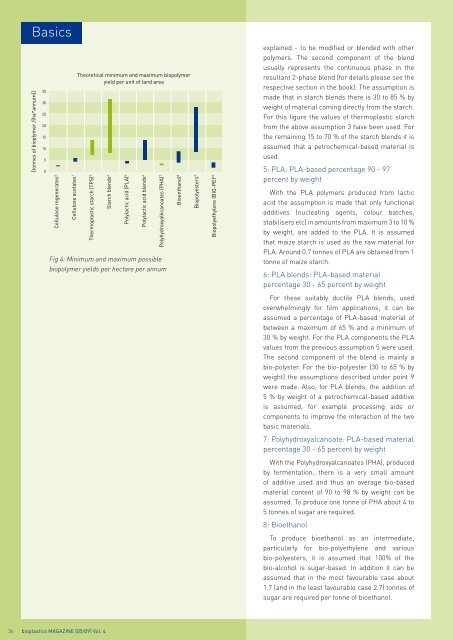bioplasticsMAGAZINE_0905
bioplasticsMAGAZINE_0905
bioplasticsMAGAZINE_0905
Create successful ePaper yourself
Turn your PDF publications into a flip-book with our unique Google optimized e-Paper software.
Basics<br />
[tonnes of bioplymer /(ha*annum)]<br />
35<br />
30<br />
25<br />
20<br />
15<br />
10<br />
5<br />
0<br />
Cellulose regenerates 2<br />
Cellulose acetates 1<br />
Theoretical minimum and maximum biopolymer<br />
yield per unit of land area<br />
Thermoplastic starch (TPS) 3<br />
Starch blends 4<br />
Polylactic acid (PLA) 5<br />
Polylactic acid blends 6<br />
Polyhydroxyalkcanoates (PHA) 7<br />
Fig 4: Minimum and maximum possible<br />
biopolymer yields per hectare per annum<br />
Bioenthanol 8<br />
Biopolyesters 9<br />
Biopolyethylene (BIO-PE) 10<br />
explained - to be modified or blended with other<br />
polymers. The second component of the blend<br />
usually represents the continuous phase in the<br />
resultant 2-phase blend (for details please see the<br />
respective section in the book). The assumption is<br />
made that in starch blends there is 30 to 85 % by<br />
weight of material coming directly from the starch.<br />
For this figure the values of thermoplastic starch<br />
from the above assumption 3 have been used. For<br />
the remaining 15 to 70 % of the starch blends it is<br />
assumed that a petrochemical-based material is<br />
used.<br />
5: PLA: PLA-based percentage 90 - 97<br />
percent by weight<br />
With the PLA polymers produced from lactic<br />
acid the assumption is made that only functional<br />
additives (nucleating agents, colour batches,<br />
stabilisers etc) in amounts from maximum 3 to 10 %<br />
by weight, are added to the PLA. It is assumed<br />
that maize starch is used as the raw material for<br />
PLA. Around 0.7 tonnes of PLA are obtained from 1<br />
tonne of maize starch.<br />
6: PLA blends: PLA-based material<br />
percentage 30 - 65 percent by weight<br />
For these suitably ductile PLA blends, used<br />
overwhelmingly for film applications, it can be<br />
assumed a percentage of PLA-based material of<br />
between a maximum of 65 % and a minimum of<br />
30 % by weight. For the PLA components the PLA<br />
values from the previous assumption 5 were used.<br />
The second component of the blend is mainly a<br />
bio-polyster. For the bio-polyester (30 to 65 % by<br />
weight) the assumptions described under point 9<br />
were made. Also, for PLA blends, the addition of<br />
5 % by weight of a petrochemical-based additive<br />
is assumed, for example processing aids or<br />
components to improve the interaction of the two<br />
basic materials.<br />
7: Polyhydroxyalcanoate: PLA-based material<br />
percentage 30 - 65 percent by weight<br />
With the Polyhydroxyalcanoates (PHA), produced<br />
by fermentation, there is a very small amount<br />
of additive used and thus an average bio-based<br />
material content of 90 to 98 % by weight can be<br />
assumed. To produce one tonne of PHA about 4 to<br />
5 tonnes of sugar are required.<br />
8: Bioethanol<br />
To produce bioethanol as an intermediate,<br />
particularly for bio-polyethylene and various<br />
bio-polyesters, it is assumed that 100% of the<br />
bio-alcohol is sugar-based. In addition it can be<br />
assumed that in the most favourable case about<br />
1.7 (and in the least favourable case 2.7) tonnes of<br />
sugar are required per tonne of bioethanol.<br />
36 bioplastics MAGAZINE [05/09] Vol. 4


















